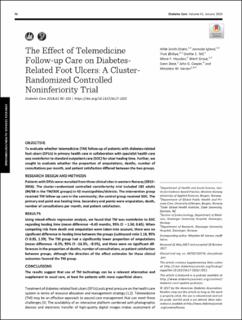| dc.contributor.author | Smith-Strøm, H. | |
| dc.contributor.author | Igland, J. | |
| dc.contributor.author | Østbye, T. | |
| dc.contributor.author | Tell, G. S. | |
| dc.contributor.author | Hausken, M. F. | |
| dc.contributor.author | Graue, M. | |
| dc.contributor.author | Skeie, S. | |
| dc.contributor.author | Cooper, J. G. | |
| dc.contributor.author | Iversen, M. M. | |
| dc.date.accessioned | 2021-07-09T11:06:19Z | |
| dc.date.available | 2021-07-09T11:06:19Z | |
| dc.date.issued | 2018 | |
| dc.identifier.citation | Smith-Strøm, H., Igland, J., Østbye, T., Tell, G. S., Hausken, M. F., Graue, M., Skeie, S. … Iversen, M. M. (2018). The Effect of Telemedicine Follow-Up Care on Diabetes-Related Foot Ulcers: A Cluster Randomized Controlled Non- Inferiority Trial. Diabetes Care, 41(1), 96–103. | en_US |
| dc.identifier.uri | https://hdl.handle.net/11250/2764040 | |
| dc.description.abstract | OBJECTIVE To evaluate whether telemedicine (TM) follow-up of patients with diabetes-related foot ulcers (DFUs) in primary health care in collaboration with specialist health care was noninferior to standard outpatient care (SOC) for ulcer healing time. Further, we sought to evaluate whether the proportion of amputations, deaths, number of consultations per month, and patient satisfaction differed between the two groups.
RESEARCH DESIGN AND METHODS Patients with DFUs were recruited from three clinical sites in western Norway (2012–2016). The cluster-randomized controlled noninferiority trial included 182 adults (94/88 in the TM/SOC groups) in 42 municipalities/districts. The intervention group received TM follow-up care in the community; the control group received SOC. The primary end point was healing time. Secondary end points were amputation, death, number of consultations per month, and patient satisfaction.
RESULTS Using mixed-effects regression analysis, we found that TM was noninferior to SOC regarding healing time (mean difference –0.43 months, 95% CI −1.50, 0.65). When competing risk from death and amputation were taken into account, there was no significant difference in healing time between the groups (subhazard ratio 1.16, 95% CI 0.85, 1.59). The TM group had a significantly lower proportion of amputations (mean difference –8.3%, 95% CI –16.3%, –0.5%), and there were no significant differences in the proportion of deaths, number of consultations, or patient satisfaction between groups, although the direction of the effect estimates for these clinical outcomes favored the TM group.
CONCLUSIONS The results suggest that use of TM technology can be a relevant alternative and supplement to usual care, at least for patients with more superficial ulcers. | en_US |
| dc.publisher | Diabetes Care | en_US |
| dc.subject | telemedicine follow-up care | en_US |
| dc.subject | diabetes related foot ulcers | en_US |
| dc.subject | trykksår | en_US |
| dc.subject | pasientsikkerhet | en_US |
| dc.title | The Effect of Telemedicine Follow-Up Care on Diabetes-Related Foot Ulcers: A Cluster Randomized Controlled Non- Inferiority Trial | en_US |
| dc.type | Journal article | en_US |
| dc.source.pagenumber | 96–103 | en_US |
| dc.source.volume | 41 | en_US |
| dc.source.journal | Diabetes Care | en_US |
| dc.source.issue | 1 | en_US |
| dc.identifier.doi | https://doi.org/10.2337/dc17-1025 | |
| dc.description.localcode | måsjekkes | |
